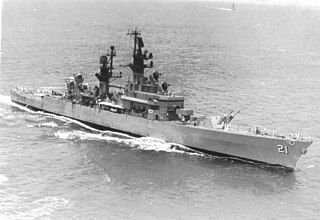
Bath Iron Works (BIW) is a major United States shipyard located on the Kennebec River in Bath, Maine, founded in 1884 as Bath Iron Works, Limited. BIW has built private, commercial, and military vessels, most of which have been ordered by the United States Navy. The shipyard has built and sometimes designed battleships, frigates, cruisers, and destroyers, including the Arleigh Burke class which are currently among the world's most advanced surface warships.
USS Bainbridge may refer to any of five warships named after the early U.S. Navy hero William Bainbridge:

USS Gridley (DLG-21/CG-21), a Leahy-class guided missile cruiser, was the third ship of the United States Navy to be named after Charles Vernon Gridley, who distinguished himself with Admiral George Dewey's force at the Battle of Manila Bay on 1 May 1898.
Two ships of the United States Navy have been named Belknap, in honor of Rear Admiral George Eugene Belknap.

The Spruance-class destroyer was developed by the United States to replace the many World War II–built Allen M. Sumner- and Gearing-class destroyers and was the primary destroyer built for the U.S. Navy during the 1970s and 1980s. It was named in honour of United States Navy Admiral Raymond A. Spruance, who successfully led major naval battles in the Asiatic-Pacific Theater during World War II such as the Battle of Midway and Battle of the Philippine Sea.

USS Leahy (DLG/CG-16) was the lead ship of a new class of destroyer leaders in the United States Navy. Named for Fleet Admiral William D. Leahy, she was commissioned on 4 August 1962 as DLG-16, a guided missile frigate, and reclassified as CG-16, a guided missile cruiser, on 30 June 1975.
Two ships of the United States Navy have been named USS Halsey in honor of Fleet Admiral William F. "Bull" Halsey (1882–1959), who served in the United States Navy during the First and Second World Wars. Both ships used guided missiles as their primary armament
USS Porter may refer to one of several ships in the United States Navy named in honor of Commodore David Porter, and his son, Admiral David Dixon Porter.
USS Dewey may refer to one of these ships of the United States Navy named in honor of Admiral George Dewey, best known for his victory at the Battle of Manila Bay during the Spanish–American War:
USS or USNS Maury may refer to the following ships, named for Commodore Matthew Fontaine Maury:
Three ships of the United States Navy have been named USS Wadsworth, in honor of Commodore Alexander S. Wadsworth:
Two ships in the United States Navy have been named USS Stevens. The first was named in honor of Captain Thomas Holdup Stevens (1795–1841), and the second for both Capt. Stevens and his son, Rear Admiral Thomas H. Stevens, Jr. (1819–1896).

USS Harry E. Yarnell (DLG/CG-17) was a Leahy-class guided missile cruiser of the United States Navy. Named in honor of Admiral Harry E. Yarnell (1875–1959), she was originally classified as a "destroyer leader" or frigate, in 1975 she was redesignated a cruiser in the Navy's ship reclassification. She was the second of the "double-end" Leahy-class guided missile frigates to join the fleet.

USS Richmond K. Turner was a Leahy-class cruiser destroyer leader in the United States Navy. The ship was named for Admiral Richmond K. Turner, who served during World War II.

New Threat Upgrade (NTU) was a United States Navy program to improve and modernize the capability of existing cruisers and destroyers equipped with Terrier and Tartar anti-aircraft systems, keeping them in service longer. It was a key component of then-President Ronald Reagan's 600-ship Navy plan.

Leahy-class cruisers were a class of guided missile cruisers built for the United States Navy. They were originally designated as Destroyer Leaders (DLG), but in the 1975 cruiser realignment they were reclassified as guided missile cruisers (CG).

USS Horne (DLG/CG-30) was a Belknap-class destroyer leader/cruiser, named for Admiral Frederick J. Horne, 1880–1959. She was launched as DLG-30, a destroyer, and reclassified a cruiser on 30 June 1975.

USS Sterett (DLG/CG-31) was a Belknap-class destroyer leader / cruiser. She was the third ship to be named for Master Commandant Andrew Sterett (1778–1807), who served during the Quasi-War with France and the Barbary Wars. She was launched as DLG-31, a frigate, and reclassified a cruiser (CG) on 30 June 1975.

The first USS Halsey, a Leahy-class guided missile cruiser was a ship of the United States Navy named in honor of Fleet Admiral William Halsey. Originally called a destroyer leader or frigate (DLG-23), on 30 June 1975 she was redesignated a cruiser (CG-23) in the U.S. Navy's ship reclassification.
This page is based on this
Wikipedia article Text is available under the
CC BY-SA 4.0 license; additional terms may apply.
Images, videos and audio are available under their respective licenses.









